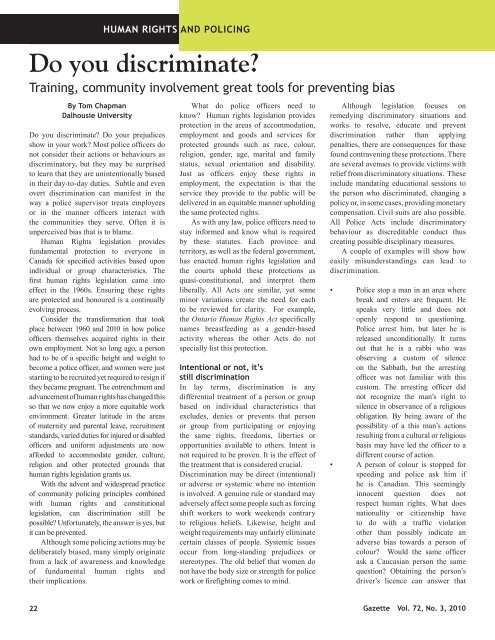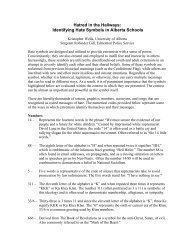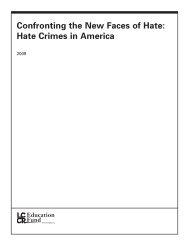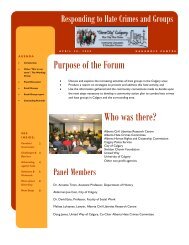RCMP Gazette Human Rights and Policing - Alberta Hate Crimes ...
RCMP Gazette Human Rights and Policing - Alberta Hate Crimes ...
RCMP Gazette Human Rights and Policing - Alberta Hate Crimes ...
You also want an ePaper? Increase the reach of your titles
YUMPU automatically turns print PDFs into web optimized ePapers that Google loves.
huMAN RiGhTShuMANAND POliCiNGRiGhTS AND POliCiNGDo you discriminate?Training, community involvement great tools for preventing biasby Tom ChapmanDalhousie universityDo you discriminate? Do your prejudicesshow in your work? Most police officers donot consider their actions or behaviours asdiscriminatory, but they may be surprisedto learn that they are unintentionally biasedin their day-to-day duties. Subtle <strong>and</strong> evenovert discrimination can manifest in theway a police supervisor treats employeesor in the manner officers interact withthe communities they serve. Often it isunperceived bias that is to blame.<strong>Human</strong> <strong>Rights</strong> legislation providesfundamental protection to everyone inCanada for specified activities based uponindividual or group characteristics. Thefirst human rights legislation came intoeffect in the 1960s. Ensuring these rightsare protected <strong>and</strong> honoured is a continuallyevolving process.Consider the transformation that tookplace between 1960 <strong>and</strong> 2010 in how policeofficers themselves acquired rights in theirown employment. Not so long ago, a personhad to be of a specific height <strong>and</strong> weight tobecome a police officer, <strong>and</strong> women were juststarting to be recruited yet required to resign ifthey became pregnant. The entrenchment <strong>and</strong>advancement of human rights has changed thisso that we now enjoy a more equitable workenvironment. Greater latitude in the areasof maternity <strong>and</strong> parental leave, recruitmentst<strong>and</strong>ards, varied duties for injured or disabledofficers <strong>and</strong> uniform adjustments are nowafforded to accommodate gender, culture,religion <strong>and</strong> other protected grounds thathuman rights legislation grants us.With the advent <strong>and</strong> widespread practiceof community policing principles combinedwith human rights <strong>and</strong> constitutionallegislation, can discrimination still bepossible? Unfortunately, the answer is yes, butit can be prevented.Although some policing actions may bedeliberately biased, many simply originatefrom a lack of awareness <strong>and</strong> knowledgeof fundamental human rights <strong>and</strong>their implications.What do police officers need toknow? <strong>Human</strong> rights legislation providesprotection in the areas of accommodation,employment <strong>and</strong> goods <strong>and</strong> services forprotected grounds such as race, colour,religion, gender, age, marital <strong>and</strong> familystatus, sexual orientation <strong>and</strong> disability.Just as officers enjoy these rights inemployment, the expectation is that theservice they provide to the public will bedelivered in an equitable manner upholdingthe same protected rights.As with any law, police officers need tostay informed <strong>and</strong> know what is requiredby these statutes. Each province <strong>and</strong>territory, as well as the federal government,has enacted human rights legislation <strong>and</strong>the courts uphold these protections asquasi-constitutional, <strong>and</strong> interpret themliberally. All Acts are similar, yet someminor variations create the need for eachto be reviewed for clarity. For example,the Ontario <strong>Human</strong> <strong>Rights</strong> Act specificallynames breastfeeding as a gender-basedactivity whereas the other Acts do notspecially list this protection.intentional or not, it’sstill discriminationIn lay terms, discrimination is anydifferential treatment of a person or groupbased on individual characteristics thatexcludes, denies or prevents that personor group from participating or enjoyingthe same rights, freedoms, liberties oropportunities available to others. Intent isnot required to be proven. It is the effect ofthe treatment that is considered crucial.Discrimination may be direct (intentional)or adverse or systemic where no intentionis involved. A genuine rule or st<strong>and</strong>ard mayadversely affect some people such as forcingshift workers to work weekends contraryto religious beliefs. Likewise, height <strong>and</strong>weight requirements may unfairly eliminatecertain classes of people. Systemic issuesoccur from long-st<strong>and</strong>ing prejudices orstereotypes. The old belief that women donot have the body size or strength for policework or firefighting comes to mind.Although legislation focuses onremedying discriminatory situations <strong>and</strong>works to resolve, educate <strong>and</strong> preventdiscrimination rather than applyingpenalties, there are consequences for thosefound contravening these protections. Thereare several avenues to provide victims withrelief from discriminatory situations. Theseinclude m<strong>and</strong>ating educational sessions tothe person who discriminated, changing apolicy or, in some cases, providing monetarycompensation. Civil suits are also possible.All Police Acts include discriminatorybehaviour as discreditable conduct thuscreating possible disciplinary measures.A couple of examples will show howeasily misunderst<strong>and</strong>ings can lead todiscrimination.• Police stop a man in an area wherebreak <strong>and</strong> enters are frequent. Hespeaks very little <strong>and</strong> does notopenly respond to questioning.Police arrest him, but later he isreleased unconditionally. It turnsout that he is a rabbi who wasobserving a custom of silenceon the Sabbath, but the arrestingofficer was not familiar with thiscustom. The arresting officer didnot recognize the man’s right tosilence in observance of a religiousobligation. By being aware of thepossibility of a this man’s actionsresulting from a cultural or religiousbasis may have led the officer to adifferent course of action.• A person of colour is stopped forspeeding <strong>and</strong> police ask him ifhe is Canadian. This seeminglyinnocent question does notrespect human rights. What doesnationality or citizenship haveto do with a traffic violationother than possibly indicate anadverse bias towards a person ofcolour? Would the same officerask a Caucasian person the samequestion? Obtaining the person’sdriver’s licence can answer that22<strong>Gazette</strong> Vol. 72, No. 3, 2010







